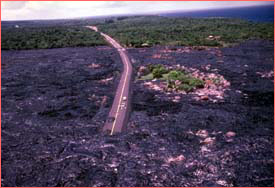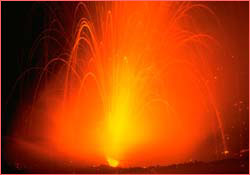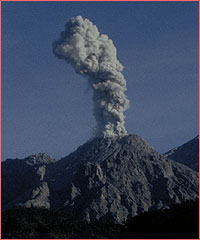
|

|

|
Eruption Type
Scientists classify volcanic eruptions based on the violence
of the eruption and the type of materials that spew out of
it. There are four basic types:
Hawaiian Eruptions
Named for the volcanoes in Hawaii, these are the least
explosive type of eruptions. Very fluid lava is
erupted, usually in the form of lava flows and lava
fountains.
|

|
Strombolian Eruptions
These are named after the Stromboli volcano in Italy.
Strombolian eruptions typically involve many small
explosions that occur in short, regular bursts. These
bursts are caused by the sudden release of bubbles of
volcanic gas as the magma rises to the surface.
|

|
Vulcanian Eruptions
Named for Vulcano, a volcanic island off the coast of
Italy, these are relatively small eruptions that eject
rock fragments, bubble-poor bombs of fresh magma, and
abundant ash. Vulcanian eruptions, like all volcanic
eruptions, are caused by buildup and then sudden
release of volcanic gas pressure.
|

|
Plinian Eruptions
These eruptions get their name from Pliny the Younger,
who described the 79 A.D. eruption of Vesuvius, near
Naples, Italy. These extremely explosive eruptions
form eruptive plumes that reach over 11 kilometers
high. The ash fall from these plumes can cover areas
hundreds of kilometers downwind of the volcano.
|

|
back to VEI chart
|
Duration
Photos: (1,2,4) USGS; (3) Andy Lockhart.
Source: USGS Photoglossary of Volcanic Terms
SWAT Team |
Predict Eruptions?
|
Deadliest Volcanoes
Planning for Disaster
| Resources |
Teacher's Guide
Transcript
| Printable page |
Site Map |
Vesuvius Home
Editor's Picks
|
Previous Sites
|
Join Us/E-mail
|
TV/Web Schedule
About NOVA |
Teachers |
Site Map |
Shop |
Jobs |
Search |
To print
PBS Online |
NOVA Online |
WGBH
©
| Updated November 2000
|
|
|






